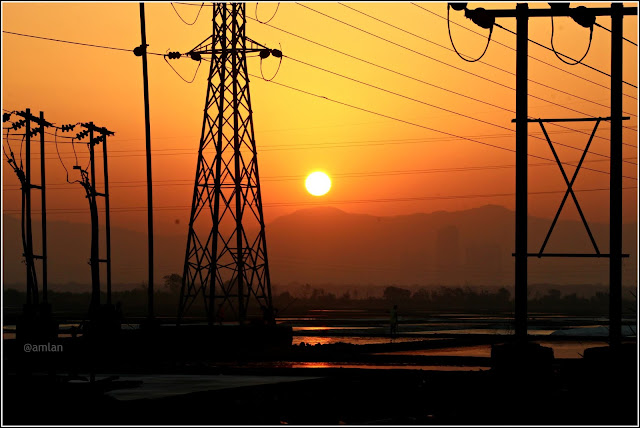BHANDUP PUMPING STATION……A UNIQUE BIODIVERSITY MICROCOSM IN HEART OF MUMBAI
The moment one hears of Mumbai, they picture this metropolis
as a concrete jungle. To a certain extent, they are not wrong as it is a concrete
jungle indeed. Having said that there are certain biodiversity platforms which
also make Mumbai a unique place in itself.
 |
| SUNRISE AT THE BHANDUP PUMPING STATION AT 0630 hrs..... |
Many have heard and read about the Borivili National Park,
which is considered as the lungs of Mumbai and National Geographic Channel did
a feature on it sometimes back. Wildlife like the leopards is at the pinnacle
of the food chain in this national park.
Not many though know about another biodiversity National
Park, of the ministry of forests, Maharashtra Government, in the suburbs of
Mumbai and that is the BHANDUP PUMPING STATION NATIONAL PARK. When I heard
about it I was little sceptical, because the Bhandup Pumping Station is
actually a sewage treatment plant and all the dirty waters from the Mumbai
metropolis is treated here. Its a huge
wastewater management system right in the suburbs of Mumbai city. So how could
this be a wildlife biodiversity sanctuary?
Well, when I went there I was amazed by the place. It has
three biomes, the mangrove biome, the grassland biome and the marshy land
biome, all in one place. All these three
biomes are possible because of the proximity to water..the creek comes in. The
tides facilitate the salt pans on one side and all the salt that Mumbaikar
consumes probably come from these salt pans’
Bhandup Pumping Station is located on the Eastern Express
Highway, near the turnoff for the Mulund Airoli Link Road.
 |
| THE SALT PANS |
 |
| HARD WORK |
The road near the salt pans is quite wide, though it gets
narrower near the pumping stations. However, it is possible to drive right up
to the creek. Also, the distance from the Highway to the creek is certainly
within walking distance. The place can be quite deserted, so it is best not to
go alone. Most Sunday mornings, there are birdwatchers in the area so you will
be sure to find company.
This place is a bird watchers paradise. Flamingos are a common sight here during the months from October to march. Besides the
commonly spotted species such as the common egret, pond heron, coppersmith
barbet, oriental magpie robin, weaver bird, golden oriole, white cheek bulbul,
common kingfisher and common cormorant, one can see species such as the painted
stork, greater and lesser flamingo, black-headed ibis, Eurasian spoonbill,
black-winged stilt, pied avocet, spot-billed duck and garganey duck.
 |
| THE FLIGHT OF THE FLAMINGO.... |
 |
| SAND PIPER...ONE HAS JUST TAKEN A FLIGHT |
Many of these, such
as the garganey duck, pied avocet and flamingos, are migratory and the main
attractions for birdwatchers that begin to flock here from November.
The best time to visit this place is around the early morning by
0630 so that one can witness the sunrise and then can walk the trail till
morning 0930 when the sun is strong and then it is not a good time to
photograph as the birds fly away to other areas.
If one is inclined to know more about the birds and their
habitat then one should register with BOMBAY NATURAL HISTORY SOCIETY as they
organize walk through with experts who will guide you with the names of the birds, their habitat, their food patterns and their migratory cycles.
This place also has some unique flora of which one is the
sausage tree, the fruit of which looks like a sausage and this tree is native
of Africa, and the Meswaak plants. Meswaak plant and its fruit is widely used
in the manufacturing of the Meswaak toothpaste, which we all have used some
times or the other.
 |
| THE MESWAAK PLANT AND ITS FRUIT |
 |
| THE SAUSAGE TREE |
On a Sunday I urge all Mumbaikars to visit this place and
feel the vibrancy and positivity of this place which is so near to our urban jungle.
Since I first came here four years ago, more and more people
have started visiting Bhandup Pumping Station during the season. Not everyone
is an avid birder. There are people who come to enjoy an early morning walk in
the microcosm of a wilderness,. There are people like me who are amateur
photographers who come to shoot nature but as long as they don’t damage the
eco-system and scare the birds by being loud, I think it’s good that it’s
slowly becoming a well-known birding spot. Everyone in the city needs to know
about this spot so that they can appreciate that in the heart of this concrete
jungle there lies solace to all.
We stand to lose
everything if we don’t preserve our wetlands. We will all have to be answerable
to our generations yet to come when they will ask, “Daddy what is a tree how
does it look like?” OR “Daddy what is a bird? Have you seen One?”









Comments
Post a Comment